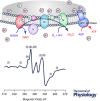Physiological and pathophysiological reactive oxygen species as probed by EPR spectroscopy: the underutilized research window on muscle ageing
- PMID: 26801204
- PMCID: PMC4983631
- DOI: 10.1113/JP271471
Physiological and pathophysiological reactive oxygen species as probed by EPR spectroscopy: the underutilized research window on muscle ageing
Abstract
Reactive oxygen and nitrogen species (ROS and RNS) play crucial roles in triggering, mediating and regulating physiological and pathophysiological signal transduction pathways within the cell. Within the cell, ROS efflux is firmly controlled both spatially and temporally, making the study of ROS dynamics a challenging task. Different approaches have been developed for ROS assessment; however, many of these assays are not capable of direct identification or determination of subcellular localization of different ROS. Here we highlight electron paramagnetic resonance (EPR) spectroscopy as a powerful technique that is uniquely capable of addressing questions on ROS dynamics in different biological specimens and cellular compartments. Due to their critical importance in muscle functions and dysfunction, we discuss in some detail spin trapping of various ROS and focus on EPR detection of nitric oxide before highlighting how EPR can be utilized to probe biophysical characteristics of the environment surrounding a given stable radical. Despite the demonstrated ability of EPR spectroscopy to provide unique information on the identity, quantity, dynamics and environment of radical species, its applications in the field of muscle physiology, fatiguing and ageing are disproportionately infrequent. While reviewing the limited examples of successful EPR applications in muscle biology we conclude that the field would greatly benefit from more studies exploring ROS sources and kinetics by spin trapping, protein dynamics by site-directed spin labelling, and membrane dynamics and global redox changes by spin probing EPR approaches.
© 2016 The Authors. The Journal of Physiology © 2016 The Physiological Society.
Figures






References
-
- Abbas K, Hardy M, Poulhes F, Karoui H, Tordo P, Ouari O & Peyrot F (2014). Detection of superoxide production in stimulated and unstimulated living cells using new cyclic nitrone spin traps. Free Radic Biol Med 71, 281–290. - PubMed
-
- Akaike T & Maeda H (1996). Quantitation of nitric oxide using 2‐phenyl‐4,4,5,5‐tetramethylimidazoline‐1‐oxyl 3‐oxide (PTIO). Methods Enzymol 268, 211–221. - PubMed
-
- Ali SS, Xiong C, Lucero J, Behrens MM, Dugan LL & Quick KL (2006). Gender differences in free radical homeostasis during aging: shorter‐lived female C57BL6 mice have increased oxidative stress. Aging Cell 5, 565–574. - PubMed
Publication types
MeSH terms
Substances
LinkOut - more resources
Full Text Sources
Other Literature Sources
Medical

